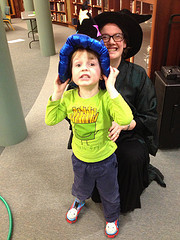Rachel Barenblat's Blog, page 198
February 27, 2013
Rabbis Without Borders: Who is your Torah for?
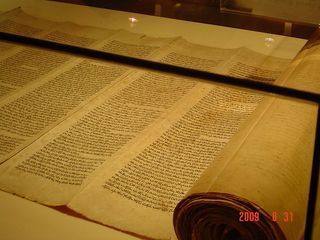 The last couple of days I've been at the second meeting of my cohort of Rabbis Without Borders fellows. It's been grand to see everyone again. One theme of our session was the rabbinate and expanding technology -- social media, its uses and misuses, who is our audience and how can we serve them, etc. I enjoyed the session with Allison Fine, author of The Networked Nonprofit; she had smart things to say. But as someone who's been active online for 20 years, and active in the Jewish blogosphere for almost a decade, I think I came to that conversation with a relatively high level of competency. So I was more excited about the other learning we did together.
The last couple of days I've been at the second meeting of my cohort of Rabbis Without Borders fellows. It's been grand to see everyone again. One theme of our session was the rabbinate and expanding technology -- social media, its uses and misuses, who is our audience and how can we serve them, etc. I enjoyed the session with Allison Fine, author of The Networked Nonprofit; she had smart things to say. But as someone who's been active online for 20 years, and active in the Jewish blogosphere for almost a decade, I think I came to that conversation with a relatively high level of competency. So I was more excited about the other learning we did together.
For me one central question of the session came from Rabbi Brad Hirschfield: who is your Torah for? Over the course of his session, he said several things which resonated with me. He urged us to try to live in a way which acknowledges the need for walls, but keeps the walls lowered as much as we can bear. ("Walls keep us safe," he agreed, "but they can also become prisons.") He exhorted us to live in a mindset of abundance. To recognize that the spiritual and the material are always interconnected. To strive to live in a spirit of both/and rather than either/or -- and to bring the same compassionate both/and response to ourselves that we bring to the world.
We studied a short text from Talmud (tractate Avodah Zarah 2b-3a) about the question of for whom the Torah was meant. And R' Brad noted the fairly remarkable truth that although that text was written during a time when Jews were tremendously persecuted (and by and large had a lot of understandable anger and anxiety around that), the Talmud still presumes that the Torah is not ours alone, that access to God is not ours alone, and that anyone who studies Torah (in the language of the text, even an idolater) is as elevated as the high priest. Here are a few of the gems from that Torah study which I tweeted as it was happening:
The most iconic Jewish text we have (Talmud) was written not in Hebrew but the English of its moment: Aramaic.
Talmud (Avodah Zarah 2b-3a) teaches: there's no boundary b/w Torah and the peoples of the world. ALL of them.
In my wished-for world, the full dignity of the ultimate outsider is affirmed along with the full dignity of the full insider.
I think it's easy for people today who don't have familiarity with Aramaic to feel as though the Talmud is a kind of walled garden -- a Jewish treasure to which they don't have access. But R' Brad reminds us that Talmud was written in the vernacular of its day; it was meant to be accessible. It wasn't an ivory tower text designed only for the insiders. Beyond that, there's a thread in our texts, if we are willing to look for it and follow it, which reminds us that the wisdom we've been blessed to receive is not ours alone. This is the kind of post-triumphalism which drew me to Jewish Renewal, and which I also find in Rabbis Without Borders/Clal. R' Brad continued:
Of course you teach the Torah you most need. But it doesn't end there.
The unfolding #Torah of our lives is also a sacred text.
I "use Jewish" to serve people. That's who my #Torah is for.
The idea that we teach the Torah we most need to learn is one which was already very close to our hearts. And so is the idea that the unfolding Torah of our lives is a sacred text -- different from the written Torah we find in our libraries, but also holy. And the idea of "using Jewish" to serve people -- bringing Jewish wisdom, Jewish tools, to bear on the work of serving God and serving humanity -- is also close to my heart. We were all asked to ponder, and to answer, the question of "who is my Torah for?" As soon as I heard the question, my answer arose in me.
 My Torah is for anyone who is thirsty. Anyone who's thirsty for connection, for community, for God. Anyone who wants to make their lives holy or to become more conscious of the holiness in the everyday. Anyone who wants access to the rich toolbox of Jewish wisdom and traditions and ideas which I am blessed to have as my yerusha, my inheritance.
My Torah is for anyone who is thirsty. Anyone who's thirsty for connection, for community, for God. Anyone who wants to make their lives holy or to become more conscious of the holiness in the everyday. Anyone who wants access to the rich toolbox of Jewish wisdom and traditions and ideas which I am blessed to have as my yerusha, my inheritance.
And then I thought: that would have been my answer ten years ago when I started this blog, too. I started writing VR for anyone who was thirsty, as I was, for connection with God and with tradition. Maybe especially for those who felt marginalized, who didn't perceive that they had a place at the table but yearned to be welcomed in.
That in turn raises the question for me: has that changed? Should it have changed? In the last ten years I've gone from being an aspirant to being, thank God, an ordained rabbi. I've gone from being someone who felt that I was outside-looking-in to being someone who feels blessed to have access to these incredible riches of tradition.
But I think my answer is actually still the same as it was. Maybe this is integral to who I am. My Torah is for anyone who yearns. I have better access now to the tools my tradition gives me for helping to connect people with meaning, to connect people with God. But I still want my Torah to be for anyone who's thirsty. "Let all who are hungry, come and eat; let all who are needy, come and celebrate the Passover with us." That message from the Passover haggadah has long been one of my favorite things; and I think it shaped me more than I know. My Torah is for you who are reading this, whenever this is, whoever you are.
February 26, 2013
To shame someone is to shed their blood
תני תנא קמיה דרב נחמן בר יצחק: כל המלבין פני חבירו ברבים כאילו שופך דמים.
One who embarrasses another in public, it is as if that person shed blood.
-- Babylonian Talmud, Baba Mezia 58b
Someone who embarrasses another person in public causes their face to turn paler (הלבין את פניו / hilbin et panav) as the blood drains away. When you shame someone, the Talmud says, it's tantamount to wounding them and shedding their blood. But online, we can't see one another's faces. If someone's blog comment or email causes the blood to drain from my face in shame or in sorrow, they don't know that; they can't see me. What -- asked one of my colleagues at the Rabbis Without Borders fellows meeting -- might be the new Gemara of how we should interact with one another in this online world?
This is something I've thought about. I've been blogging here since October of 2003, so almost ten years. And for the most part, my efforts to create and foster a kind and thoughtful community of conversation have been successful. I'm endlessly grateful to all of y'all who have contributed to those conversations over the years! But I've also been verbally attacked for things I've posted here. (And I'm not even going to link to things like the so-called Self Hating Israel Terrorists list -- whose name is such a delightful acronym -- and the things they say about people with whom they disagree.)
One of my dear friends and teachers, Rabbi Sami Barth, has a quote from Rabbi Abraham Joshua Heschel in his email signature and on his website. The quote is this: "When I was young I admired clever people; now that I am older I admire kind people." I'm right there with him on that one. Cleverness may be impressive, and there have been times in my life when I have wanted to be clever and to be admired for that, but these days kindness is what I really aspire to. And I like to spend my time in places, both online and off, where that value prevails.
But there's no discounting the reality that there are a lot of places on the internet where kindness and compassion don't seem to be the operating principles. I expect that anyone who has a blog has experienced some nastiness. And often it's the kind of nastiness that (I hope) perfect strangers would never choose to direct at someone in person. (See the xkcd cartoon Listen to Yourself.) But why, then, do they feel entitled to direct it at them via the internet? By what ethic is meanness an appropriate way to treat someone?
One of my colleagues, Rabbi Harry Brechner, suggests the following rubric. Before posting or sending anything, ask yourself: is it true? is it kind? is it important? He suggests that one should be certain that at least two of the three can be answered with "yes" before putting it out there.
As far as I'm concerned, the Talmudic teaching from Bava Metzia -- that someone who shames another person, it is as though they have spilled blood -- is every bit as true online as offline. A blog is a public space. When someone comes to my blog and insults me, or my teachers, or my teachings, or my values there, it is as though that person had shamed me in public. Because they have.
Being insulted or shamed in person and being insulted or shamed online feel quite similar. The blood drains out of the face, the heart pounds in the chest, tears hammer at the back of the eyes, a painful knot forms in the throat in exactly the same way, regardless of whether it's happening in the public square or on a blog. Beyond that: something cruel or shaming, once posted on the internet, is often persistent. It's searchable. It stays there.
I keep coming back to R' Harry Brechner's threefold communication rule: is it true? is it kind? is it important?
The things we write online feel important to us. And surely most of us say things we think are true. (I could argue with the veracity of some of those things -- so much depends on one's sources, what one reads, who one believes -- but I'm willing to give most people the benefit of the doubt and assume that they post things they perceive to be true.) But I wish kindness were more often at the forefront of our consciousness.
For me, any evolving Gemara which takes the internet and social media into account needs to recognize that interactions between people online are still interactions between people. The way we treat each other online needs to be as compassionate, and as rooted in holiness and in Torah, as the way we would treat each other anywhere.
VR at Reform Judaism and at Ritualwell
My thanks go to the editors at the Reform Judaism blog for reprinting my post Every body is a reflection of God. I serve a Reform shul and I'm delighted to have that post circulating to the broad Reform community.
And my thanks are also due to the editors at Ritualwell, who asked me to write a short essay about miscarriage, spirituality, and ritual. It's here: Through (Ritualwell). Here's how it begins:
Some years ago I flew to Colorado for OHALAH, the annual gathering of
Jewish Renewal clergy and student clergy, carrying a dazzling secret: I
was newly-pregnant. When I danced at kabbalat Shabbat
services, I was already imagining what it would be like to bring an
infant with me the following year. And then I went to bed feeling uneasy
with cramps, and woke to blood everywhere.
That Shabbat was endless, and it was awful. What I remember most about
that terrible day was the way that—as word spread—woman after woman came
up to me to tell me it had happened to her, too. I had unknowingly
joined a club of which many of my friends and teachers were already
members. Once, twice, three times … Each of them had stories to tell,
and though they could not offer healing, there was comfort in knowing
that I was not alone—that so many other women carried this invisible
scar.
You can read the whole thing at Ritualwell, along with a variety of other resources for pregnancy loss. They also linked to my free chapbook of miscarriage poems, Through. Thanks, Ritualwell editors. May all who suffer that grief find comfort, speedily and soon.
February 25, 2013
A melody before the seder's cups of wine
הִנְנִי מוּכָן וּמְזוּמָּן לְקַיֵּם מִצְוַת כּוֹס רִאשׁוֹנָה מֵאַרְבַּע כּוֹסוֹת לְשֵׁם יִחוּד קוּדְשָׁא בְּרִיךְ הוּא וּשְׁכִינְתֵּיהּ.
Hin'ni muchan u-m'zuman l'kayem mitzvat kos rishonah m'arbah cosot l'shem yichud kudsha brich hu u-schinteh.
May my consumption of this first of four cups of wine create healing, effecting a unification between the Holy Blessed One and Shekhinah, God far beyond & God deep within.
That text appears in both of the current editions of the Velveteen Rabbi's Haggadah for Pesach (the 48-page version and the 82-page version) -- with the obvious changes ("first of four cups" becomes "second," "third," then "fourth") -- before each of the seder's prescribed cups of wine.
The formula which invites one to perform a mitzvah for the sake of the
unification of the Holy Blessed One and the Shekhinah (לשם יחוד קודשא בריך הוא ושכינתיה) appears in a
variety of places in traditional Jewish practice. Some say those words before putting on tefillin, or before counting the Omer. The Baal Shem Tov urged his followers to say those words before doing any mitzvah. I like to say them before each of the seder's four cups of wine.
When we read this little pre-prayer intention before each cup of wine, we invest our consumption with the hope that as we bless and drink, we will be able to effect a unification between the Kadosh Baruch Hu and the Shekhinah. Between the transcendent aspect of God which is beyond our ken, and the immanent aspect of God which is embodied in creation. Between divinity we can scarcely begin to comprehend, and divinity we experience in our daily lives.
These words presume that mitzvot have meaning, and that when we do them
mindfully and with a whole heart, we have the capacity to impact the
very being of God.
In recent years I've been aware of wanting some way to really enter into this prayer before each of the seder's four glasses of wine. And aware, too, that while the kabbalistic language speaks to me, these concepts may be strange or unfamiliar for many seder-goers. I'm not sure that pausing the seder and offering further discursive explanations actually serves the purpose of helping people enter into this practice.
Enter melody.
I'm not a songwriter, so I was surprised when this chord progression and this simple melody came to me. But I was casting about for some way of making this small prayer more accessible, and the melody arose. So I said thank-you for it, and I recorded it in three ways: as a niggun (above), as a song (intended to be sung before the first time this kabbalistic formula is recited), and in a shortened version which leads right into the blessing over wine. Here's the song:
And here's the version which uses only the first few words (הִנְנִי מוּכָן וּמְזוּמָּן) and then moves into the blessing over wine.
If this practice speaks to you, and if this melody speaks to you, feel free to make use of them in your seder(s). The first seder is four weeks from tonight! I want to be attentive to what quickens in me as this festival approaches. Behold: I am ready...
February 24, 2013
70 faces reading in Northampton
For those who are interested in more information about the Torah poetry reading, and the Torah poetry workshop, I'll be doing at CBI Northampton in a couple of weekends, here's a flyer created by the folks at CBI -- feel free to download and to share!
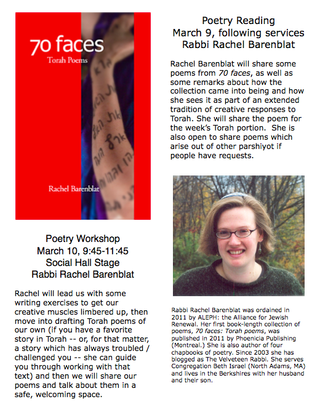
Here's the flyer for download: Rachel.pdf
Hope to see some of y'all there!
February 23, 2013
Happy Purim / חג פורים שמח!
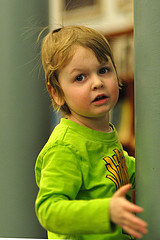
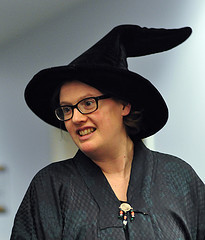
We had a sweet little Purim shindig at my shul tonight. A few folks decorated masks beforehand with the markers and stickers which Drew and I had purchased at the art supply store. Then we all adjourned into the sanctuary for our Purim Spiel, ably written and directed by my friend David Lane.
I chanted a handful of verses from the megillah, and our Purim players retold the Purim story in fine style. Then we adjourned for hamentaschen (and tiny cupcakes, Drew's favorite) and, for the adults, a few celebratory nips of slivovitz. And then I brought Drew home while the party was still going on, because it was already well past his bedtime.
I came home to a beautiful Purim poem by my friend Kate Abbott. It's called Mordechai -- scroll down to reach the poem on that page. I love her imaginative insights into what it might have been like for Mordechai to rear the orphan Esther.
Whatever your Purim may hold, I wish you ora v'simcha, light and joy.
Professor MacGonagall and her son say: Happy Purim to all!
For more images from our Purim celebration, don't miss the Purim, 13
photoset at my congregation's Flickr account.
(The individual photos,
above, are from that photoset, and were taken by Len Radin -- thanks,
Len! The one of Drew and me is a cameraphone photo, but I love it anyway.)
February 22, 2013
Rehab
What moves me, right away, is the gentleness. They're standing a few feet apart, two adults younger than I am, each of them coaching someone elderly. They help them rise from their wheelchairs, stand with relative stability, and toss a bright plastic ball back and forth, back and forth. Each of the patients wears a wide striped belt for the therapist to hold onto.
After the game of catch, they work with cones. Each plastic cone is slightly smaller than a soda can, and each is a different vivid color, red and green and yellow and blue. Each physical therapist holds a cone somewhere just out of reach, and prompts their patient to reach for it, to stretch or bend as needed, and then to hand it to her or his counterpart. Back and forth.
Afterward I chat with the woman I am there to visit. She praises the physical therapists: they're young, she agrees, but they know what they're doing. She tells me that she's gotten to know everyone there, at least enough to greet them and say hello. And when someone is in really bad shape, she says, and they manage something they hadn't been able to do -- that's inspiring.
It has the feel of a kind of strange private club, though not a club anyone particularly wants to join. Its accoutrements are so determinedly cheerful they remind me of preschool. My son would love the mats, the cones, the ball. I wonder how many of the people there wrestle with frustration at needing to practice things like balance, or grasping, or bending down.
What fragile things these bodies can be. Thin skin and delicate bones and so many places that can hurt. I want to bless the hands and heart of every doctor and nurse, every physical therapist, every orderly. Afterwards I take myself out for a quick Chinese lunch. I warm my hands on a teacup. I whisper prayers into my tea.
70 faces events at CBI Northampton
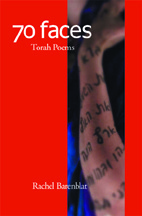
On March 9 and 10 I'm doing two special events at CBI Northampton -- a congregation which shares a name with my shul in North Adams, but is located some 75 minutes away in a college town in the Pioneer Valley.
On Shabbat morning at 12:30pm -- after Shabbat morning services -- I'll give a reading from 70 faces (Phoenicia, 2011) in the synagogue library. I'll share some poems from the collection, as well as some remarks about how the collection came into being and how I see it as part of an extended tradition of creative responses to Torah. I have a few poems I always like to read at an event like this one, and I'll definitely share the poem for the Torah portion of that week, but I'm also open to share poems which arise out of other parshiyot if people have requests.
And on Sunday morning at 9:45am, I'll be teaching a Torah poetry workshop on the stage of the CBI Northampton social hall. We'll begin with some writing exercises to get our creative muscles limbered up, then move into drafting Torah poems of our own (if you have a favorite story in Torah -- or, for that matter, a story which has always troubled / challenged you -- I can guide you through working with that text) and then will share our poems and talk about them in a safe, welcoming space.
This year, CBI Northampton's adult education programs all dovetail with their learning theme for the year, a focus on ecology and the environment -- so in the Torah poems workshop, I'll be inviting us to be attentive not only to the details of the Torah text but also to the ways in which the natural world manifests in the Torah and in our poems.
All are welcome; if you're in the region, please join us!
February 20, 2013
Purim Pantoum
The king wants to reveal
but Vashti's body is her own.
What if every woman were so uppity?
his courtiers tsk and cluck.
But Vashti's body is her own:
the veil is her comfort.
His courtiers tsk and cluck.
Ladies whisper behind soft hands.
The veil is her comfort
as the palace doors open.
Ladies whisper behind soft hands
a new chapter is unfolding.
As the palace doors open
girls pour in like the sea.
A new chapter is unfolding.
Who will be chosen to serve?
Girls pour in like the sea.
Esther, the bright orphan
who will be chosen to serve
keeps her own counsel.
Esther, the bright orphan --
she piques the king's interest
keeps her own counsel
she knows how to curtsey.
She piques the king's interest
with fine foreign features.
She knows how to curtsey --
no one asks women to bow.
Her fine foreign features
don't mark her as a stranger.
No one asks women to bow
but men have their pride.
Don't mark her as a stranger!
Mordechai stands tall
(men have their pride)
Haman hammers. At his gallows
Mordechai stands tall.
Is this why Esther was chosen?
Haman hammers at his gallows.
She plucks her courage in both hands.
Is this why Esther was chosen?
The invisible hand of God at work?
She plucks her courage in both hands --
Tell the truth of who you are.
The invisible hand of God at work?
The King wants to reveal.
Tell the truth of who you are.
What if every woman were so uppity?
Purim is a topsy-turvy holiday, a holiday of inversions. I wanted to write another Purim poem, and the pantoum -- with its inversions and recontextualizations -- seemed like the perfect form. I welcome questions and/or comments. Enjoy!
(Related: Hidden, a poem about Esther, 2011.)
February 19, 2013
Jews and Words, by Oz-Salzberger and Oz
Jewish continuity has always hinged on uttered and written words, on an expanding maze of interruptions, debates, and disagreements, and on a unique human rapport. In synagogue, at school, and most of all in the home, it has always involved two or three generations deep in conversation.
Ours is not a bloodline but a textline.
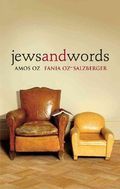 That's the opening of Jews and Words, by Amos Oz and Fania Oz-Salzberger. Amos Oz is a novelist whose works are read around the world; he teaches at Ben-Gurion University in Be'er Sheva. Fania Oz-Salzberger, his daughter, is a writer and history professor at the University of Haifa. Together they have authored a short nonfiction book -- you might think of it as a very long essay in four chapters -- called Jews and Words, which I am just beginning to read.
That's the opening of Jews and Words, by Amos Oz and Fania Oz-Salzberger. Amos Oz is a novelist whose works are read around the world; he teaches at Ben-Gurion University in Be'er Sheva. Fania Oz-Salzberger, his daughter, is a writer and history professor at the University of Haifa. Together they have authored a short nonfiction book -- you might think of it as a very long essay in four chapters -- called Jews and Words, which I am just beginning to read.
Thus far I've read the first chapter, out of four, and it's already given me plenty I want to share with y'all.
Oz and Oz-Salzberger identify themselves upfront as secular Jewish Israelis. They unpack that statement into three components: they do not believe in God; Hebrew is their mother tongue; and their Jewish identity is not faith-powered. None of these things is true for me (well -- I'm not sure what's at the deepest root of my Jewish identity, though that identity currently plays out in ways which are integrated with faith) and yet none of our differences get in the way of my finding their writing compelling and beautiful.
And I can't help loving the fact that these two self-identified atheists still begin the book's first chapter, "Continuity," with a quote from the anonymous medieval Sefer Yetzirah. In my general experience, people who toss around ideas from the Sefer Yetzirah tend to be rabbis or kabbalists of some stripe, not self-identified atheists. Then again: what writer, anywhere, could fail to find resonant the idea that the very universe came into being through text, and that the letters of the alphabet are the foundation of all things?
While Abraham argued with God and Moses reiterated God's words, the Mishnaic and Talmudic rabbis are in the business of unraveling, elucidating, explaining, and counter-explaining God and Abraham and Moses. Prophecy is mystical, but exegesis is human.
Unraveling, elucidating, explaining and counter-explaining: these acts are central to the whole business of being Jewish. I make this argument every time I teach about midrash -- that in some ways, what makes us Jews is our perennial engagement with these texts and with each others' interpretations of these texts. We weave ourselves into the fabric of tradition when we interact with previous generations' interpretations of the texts with which we still wrestle. (I often make this case alongside a case that fandom operates in a similar way. Fans, like Jews, constitute community through engaging with shared source-texts together, and through responding to one anothers' responses.) Unraveling, elucidating, explaining, and counter-explaining make us who we are.
The Jewish calendar lays down its daily, weekly, monthly, and annually recurring texts. Repetition can drain creativity, for sure, but it also has the strange ability to anchor, nurture, and even surprise. Reiterated lines sometimes beget music[.]
As I continue to interact with our texts on daily and weekly and monthly and annual levels, I recognize that there are moments when the repetition is numbing and moments when the repetition is uplifting and surprising. When I daven the same prayer day after day or week after week, it changes -- sometimes it changes me; sometimes it changes in me. And as far as reiterated lines, or reiterated words, begetting music -- that's exactly what sparked Command (Tzav) and Naked (Acharei Mot). When I open myself to them, the repeated words of our texts "anchor, nurture, and even surprise" me, time after time, year after year.
For Jews, the authors argue, "[d]ebate and dispute are ingrained onto the process of reading." And, they note, from Mishnaic times through the now-vanished world of the Eastern European shtetl, even the poorest Jewish children learned Hebrew from the age of three until thirteen. (Male children, generally, though in wealthier families the girls sometimes learned too. The paradigm shift involved in regarding women as men's intellectual and spiritual equals wasn't much faster in our community than anywhere else in human history.) But the point stands that, by and large, Jewish children have long been taught to read and to engage with texts. Reading, learning, and questioning are at the heart of our tradition.
Some hold that the Torah guards us as long as we guard the Torah, or that Shabbat keeps the Jews healthy and whole when we keep Shabbat in the same way. "Our own take is not radically different," father and daughter write. "What kept the Jews going were the books." Are the books inherently holy, or do we consecrate them through our study? "We hold one answer, and the faithful hold another," they note. (For my own part, I'm inclined to believe both of those stances at the same time.)
[I]f there is any chain at all between Abraham and us, it is made of written words. Like our ancestors, we are texted. And -- if one further liberty with the English language is permitted -- we are texted to our ancestors.
I love this wordplay. We are texted to our ancestors. Yes, indeed.
Here's one more quote to whet your appetite:
There is something singular in the past-gazing creativeness of those multitudes of literate Jews, their cumulative records, and their capacity to keep talking and making sense to each other across vast stretches of time, across languages and across cultures. They are all talking to one another. Like a constant argument at a never-ending Sabbath meal, it is not likeability or like-mindedness that keeps the flame alive; it is the lexicon of great issues and deep familiarities.
This short book is dense. I find that I want to read it in brief bursts and then spend time reflecting on what I have read. I expect that at this pace, it will take me a while to move all the way through it. But I am loving it, so far, and if these themes and subjects matter to you, I commend the book to you as well.
For more:
A Compelling, Chutzpadik History Of 'Jews And Words' at NPR.org
Jews and Words at Yale University Press
Keeping it in the family, The Economist's interview (audio) with Oz and Oz-Salzberger
Rachel Barenblat's Blog
- Rachel Barenblat's profile
- 6 followers


